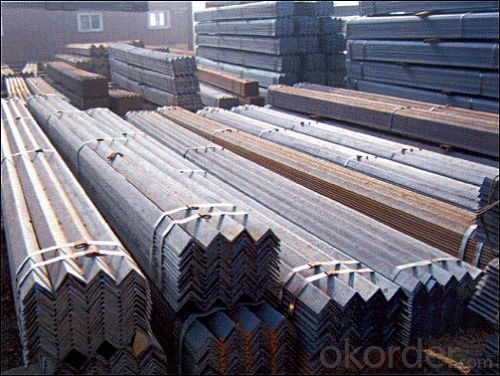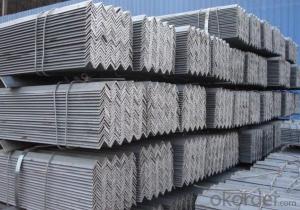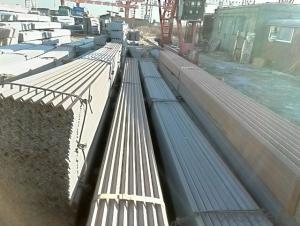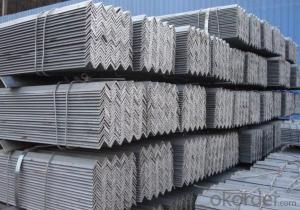Best Quality Angle Steel
- Loading Port:
- China Main Port
- Payment Terms:
- TT OR LC
- Min Order Qty:
- -
- Supply Capability:
- -
OKorder Service Pledge
OKorder Financial Service
You Might Also Like
Thickness | 3-24 mm |
Length | 6m,9m,12m or as required |
Standard | GB/T 9787-2008,GB/T 706-2008, JIS G3101,ASTM |
Material | Q195, Q215, Q235, Q345, SS400, A36 |
Surface treatment | Mill finish/ Galvanized |
Equal Angle | Type: 2#-20# Size: 20-200mm Thickness: 3.0-24mm Weight: 0.597-71.168kg/m |
Unequal Angle | Type: 2.5*1.6-20*12.5# Size:25*16-200*125mm Long Side: 25-200mm Short Side: 16-125mm Thickness: 3.0-18mm Weight: 1.687-43.588kg/m |
Application | widely used in a variety of architectural and engineering structures,such as a.) beams, bridges, ship; b.) transmission tower, reaction tower; c.) lifting transportation machinery; d.) industrial furnace; e.)container frame, warehouse goods shelves, etc |
Chemical Composition | C<0.22% Mn: 0.30—0.65% P<0.060% S<0.060% |
- Q: Bearing capacity of angle steel and channel steel
- According to the channel shape and can be divided into 4 kinds: cold bending equilateral channels, cold-formed non equilateral channel steel, cold rolled edge channels, the cold bending edge channels.According to the theory of steel structure, it should be stressed by the channel plate, that is to say, the channel should stand rather than lie prone.
- Q: How do steel angles contribute to the overall safety of a building?
- Angle irons, also known as steel angles, play a vital role in improving the overall safety of a building. These structural elements have unique properties and advantages that make them widely used in construction. To begin with, steel angles contribute to the structural support and stability of a building. They are commonly utilized to reinforce and strengthen the framework, particularly at critical load-bearing points. By distributing and transferring weight and forces, steel angles prevent excessive deflection or deformation of the building, ensuring its integrity and stability, even under heavy loads or adverse conditions. This reinforcement is particularly crucial in tall buildings or structures located in earthquake-prone or high-wind regions. Moreover, steel angles enhance the safety of a building by acting as protective barriers or shields against potential hazards. For instance, they can be installed as guards or handrails on staircases, balconies, or elevated platforms. These barriers play a vital role in preventing accidental falls or injuries, creating a secure environment for occupants. Steel angles can also be utilized to create safety barriers around machinery or equipment, preventing unauthorized access or accidental contact. Additionally, steel angles contribute to enhancing fire resistance in buildings. Steel is inherently fire-resistant and does not contribute to the spread of flames. By incorporating steel angles into the structural design of a building, it becomes possible to effectively support fire-rated walls, partitions, or fireproof doors. This facilitates the compartmentalization of the building, slowing down the spread of fire and allowing occupants more time to evacuate safely. Furthermore, steel angles offer longevity and durability, making them an ideal choice for long-term safety. Steel is highly resistant to corrosion, weathering, and other environmental factors, ensuring the structural integrity of the building over time. This durability reduces the risk of sudden structural failures or collapses, thereby enhancing overall safety for occupants and nearby structures. In conclusion, steel angles play a significant role in improving the overall safety of a building. Their ability to provide structural support, act as barriers, enhance fire resistance, and offer durability make them crucial components for ensuring the stability and protection of a structure and its occupants.
- Q: What is the typical yield stress of steel angles?
- The yield stress of steel angles can differ based on the grade and type of steel utilized. Nevertheless, for frequently employed carbon steels, the yield stress typically varies between 36,000 and 50,000 psi. This indicates that the steel angles can endure a specific level of stress or pressure prior to experiencing deformation or permanent alteration in shape. It is crucial to acknowledge that distinct steel alloys and treatments can lead to different yield stresses. Therefore, it is essential to refer to the specific specifications or reference materials pertaining to the particular steel angle in question.
- Q: Can steel angles be used in automotive chassis construction?
- Yes, steel angles can be used in automotive chassis construction. Steel angles, also known as angle irons, are commonly used in the construction industry for their strength and versatility. In automotive chassis construction, steel angles can be used to provide structural support and reinforcement to the chassis frame. Steel angles are often used to create the frame structure of a vehicle's chassis, providing a stable and rigid framework. They can be used to form the main longitudinal and cross members, as well as other structural components. The use of steel angles in automotive chassis construction offers several advantages. Firstly, steel is a strong and durable material, making it suitable for withstanding the various stresses and loads experienced by the chassis. Steel angles can also be easily fabricated and welded, allowing for flexibility in design and customization. Moreover, steel angles are cost-effective compared to other materials such as aluminum or carbon fiber. This makes them a popular choice in automotive chassis construction, especially for mass-produced vehicles where cost efficiency is crucial. However, it is important to consider the specific requirements and regulations of the automotive industry when using steel angles in chassis construction. Chassis design must meet certain safety standards, including crashworthiness and structural integrity. Therefore, it is essential to ensure that the chosen steel angles and their dimensions are appropriate for the intended application and comply with relevant regulations. In conclusion, steel angles can indeed be used in automotive chassis construction. Their strength, versatility, cost-effectiveness, and ease of fabrication make them a suitable choice for creating the frame structure of a vehicle's chassis. However, it is important to consider safety regulations and ensure that the chosen steel angles meet the required standards.
- Q: What is the typical thickness of a steel angle?
- The typical thickness of a steel angle can vary depending on the specific application and the required strength. However, in general, steel angles are available in a range of thicknesses starting from 1/8 inch (3.18 mm) and can go up to 3/4 inch (19.05 mm) or even thicker. The chosen thickness will ultimately depend on factors such as the load-bearing requirements, structural design, and the desired level of durability.
- Q: What are steel angles?
- Steel angles are L-shaped structural components made from steel, typically used in construction and engineering projects. These angles have two perpendicular legs that provide strength and stability, making them suitable for various applications such as supporting beams, framing structures, and reinforcing corners. Steel angles come in different sizes and thicknesses to meet specific project requirements and can be easily welded, bolted, or screwed into place.
- Q: Can steel angles be used to create decorative elements in architecture?
- Yes, steel angles can definitely be used to create decorative elements in architecture. These versatile structural components can be bent or shaped into various angles and forms, allowing architects and designers to incorporate them into the overall aesthetic of a building. From ornamental railings and window frames to decorative beams and columns, steel angles offer both strength and design possibilities, making them an ideal choice for decorative elements in architecture.
- Q: What are the common applications of steel angles in architecture?
- Due to their versatility and strength, steel angles are extensively utilized in architecture for various purposes. Here are some common applications of steel angles in architecture: 1. Building construction often relies on steel angles as structural support elements. By welding or bolting them together, a robust framework is formed, providing the necessary strength and stability to the structure. 2. Steel angles are commonly employed in framing applications, such as constructing door and window frames, as well as roof trusses. They ensure rigidity and support, ultimately contributing to the stability and longevity of the overall structure. 3. Reinforcing concrete structures is another popular use of steel angles. Embedding them into concrete walls, columns, and beams enhances their load-bearing capacity and resistance to deformation. 4. Staircases and handrails are frequently constructed using steel angles. These angles form a sturdy framework that guarantees the safety and stability of these architectural elements. 5. Steel angles are also employed for architectural detailing purposes. They can be utilized to create decorative elements like cornices, brackets, and ornamental features, which enhance the aesthetic appeal of the building. 6. In industrial settings, such as factories and warehouses, steel angles are utilized to create robust platforms, mezzanines, and equipment supports. In summary, steel angles are a versatile and reliable material that offers numerous benefits for architectural applications. Their strength, durability, and flexibility make them an ideal choice for a wide range of architectural structures and features.
- Q: What are the common surface preparations for painting steel angles?
- Common surface preparations for painting steel angles typically include cleaning the surface to remove dirt, grease, and rust. This is followed by sanding or blasting to create a roughened texture for better paint adhesion. Finally, a primer is applied to protect against corrosion and provide a suitable base for the topcoat.
- Q: What are the different methods of surface preparation for painting steel angles?
- Some different methods of surface preparation for painting steel angles include abrasive blasting, chemical cleaning, and power tool cleaning. Abrasive blasting involves using high-pressure air or water to propel abrasive materials onto the surface of the steel angle, removing any rust, scale, or other contaminants. Chemical cleaning involves applying specific chemicals to the steel angle to dissolve or remove any contaminants. Power tool cleaning involves using power tools such as grinders or sanders to mechanically remove any rust, scale, or other contaminants from the surface of the steel angle.
Send your message to us
Best Quality Angle Steel
- Loading Port:
- China Main Port
- Payment Terms:
- TT OR LC
- Min Order Qty:
- -
- Supply Capability:
- -
OKorder Service Pledge
OKorder Financial Service
Similar products
Hot products
Hot Searches
Related keywords



























